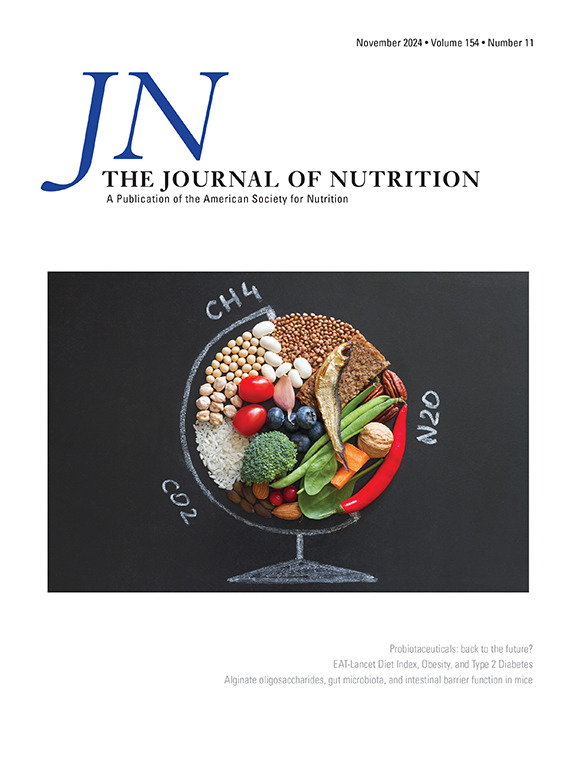高血浆18β-甘草次酸水平与2型糖尿病患者更强化的降压治疗、顽固性高血压和明显的矿化皮质激素过量有关。
IF 3.8
3区 医学
Q2 NUTRITION & DIETETICS
引用次数: 0
摘要
背景:过量食用甘草酸(甘草衍生物质)可导致血压升高和明显的矿化皮质激素过量(AME)。然而,由于甘草酸的来源不明,自我报告的摄入量可能不可靠。甘草酸的主要代谢物18β-甘草酸(GA)的血浆水平可能作为暴露的生化标志物。识别高血浆GA水平的个体可能与高危患者的BP管理有关。目的:探讨2型糖尿病(T2D)患者血浆GA水平与血压、降压治疗强度、顽固性高血压及AME生化指标的相关性。方法:在这项横断面研究中,我们测量了1160例T2D患者血浆中的GA。参与者被分为高GA(上四分之一)和低GA(下三分之一)。线性和逻辑回归模型评估GA水平与血压、降压治疗强度(定义日剂量;DDD)),顽固性高血压和AME标志物。根据年龄、性别、社会人口统计学、生活方式、糖尿病病程、eGFR、HbA1c、HOMA2S以及适当的收缩压和治疗等混杂因素对模型进行调整。结果:与低GA相比,高GA与高BP无显著相关性,但与更强化的降压治疗相关(+0.28 DDD [0.03-0.52], p=0.03)。高GA也与抵抗性高血压的高风险相关(调整后OR为1.91 [1.12-3.24],p=0.02)。此外,高GA水平与AME标志物(醛固酮降低(-41.5 pmol/L[-63.1—20.0])相关。结论:高GA水平可能是过量甘草摄入的标志物,与T2D患者降压治疗强度、顽固性高血压和与AME一致的生化标志物相关。这些发现表明,与甘草相关的暴露可能与该人群的BP管理有关。本文章由计算机程序翻译,如有差异,请以英文原文为准。
High Plasma 18β-Glycyrrhetinic Acid Levels Are Associated With More Intensive Antihypertensive Treatment, Resistant Hypertension and Apparent Mineralocorticoid Excess in Patients With Type 2 Diabetes
Background
Excessive consumption of glycyrrhizin (GL), a licorice-derived substance, can cause blood pressure (BP) elevation and apparent mineralocorticoid excess (AME). However, self-reported intake can be unreliable due to unrecognized sources of GL. Plasma levels of 18β-glycyrrhetinic acid (GA), a major metabolite of GL, may serve as a biochemical marker of exposure. Identifying individuals with high plasma levels of GA could be relevant in BP management in at-risk patients.
Objectives
To examine whether plasma levels of GA are associated with BP, antihypertensive treatment intensity, resistant hypertension, and biochemical markers of AME in patients with type 2 diabetes (T2D).
Methods
In this cross-sectional study, we measured GA in plasma from 1160 patients with T2D. Participants were divided into high GA (top quartile) and low GA (bottom 3 quartiles). Linear and logistic regression models assessed associations of GA levels with BP, antihypertensive treatment intensity (defined daily dose; DDD), resistant hypertension and markers of AME. Models were adjusted for confounders such as age, sex, sociodemographic, lifestyle, diabetes duration, estimated glomerular filtration rate, glycated hemoglobin, homoeostasis model assessment 2 for insulin sensitivity, and where appropriate systolic BP and treatment.
Results
High GA was not significantly associated with higher BP but with more intensive antihypertensive treatment (+0.28 DDD [0.03–0.52], P = 0.03) compared with low GA. High GA was also associated with higher risk of resistant hypertension (adjusted odds ratio: 1.91 [1.12–3.24], P = 0.02). Additionally, high GA was associated with markers of AME (lower aldosterone (−41.5 pmol/L [−63.1 to −20.0]; P < 0.001), lower potassium (−0.06 mmol/L [−0.10 to −0.01]; P = 0.01), lower cortisone (−6.08 nmol/L [−7.78 to −4.38]; P < 0.001), and higher cortisol/cortisone ratio (+1.26 [1.00–1.52]; P < 0.001)).
Conclusion
High GA levels, a possible marker of excessive licorice consumption, were associated with greater antihypertensive treatment intensity, resistant hypertension and biochemical markers consistent with AME in patients with T2D. These findings suggest that licorice-related exposure may be relevant to BP management in this population.
求助全文
通过发布文献求助,成功后即可免费获取论文全文。
去求助
来源期刊

Journal of Nutrition
医学-营养学
CiteScore
7.60
自引率
4.80%
发文量
260
审稿时长
39 days
期刊介绍:
The Journal of Nutrition (JN/J Nutr) publishes peer-reviewed original research papers covering all aspects of experimental nutrition in humans and other animal species; special articles such as reviews and biographies of prominent nutrition scientists; and issues, opinions, and commentaries on controversial issues in nutrition. Supplements are frequently published to provide extended discussion of topics of special interest.
 求助内容:
求助内容: 应助结果提醒方式:
应助结果提醒方式:


